joelchan's working notes
Powered by 🌱Roam Garden@kneelandExploringUnchartedTerritory2020 for [[QUE - How might domain distance modulate the effects of analogies on creative output?]] | teams with broader prior patent experience more likely to generate outlier patents; examples of long search paths and distant recombination leading to outlier patents
basically sampled people to talk to based on "outlier" outputs (quant), and then talked to them and did qual analysis to identify themes of how they came up with their inventions. that's the first part anyway.
this is more of an informal theory-building (in the m/Grounded Theory lite sense) than empirical findings per se, i think. and it says nothing about the extent to which these are the only or most important mechanisms for generating outlier innovations.
most interesting for us i think is the idea of long search paths, which they describe as an innovation that looks like a very large leap from previous ideas, but is actually composed of a lot of small(er) improvements that combine over time, and are known only to the inventor
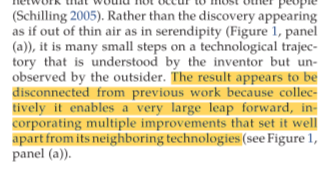 (p. 540)
(p. 540)
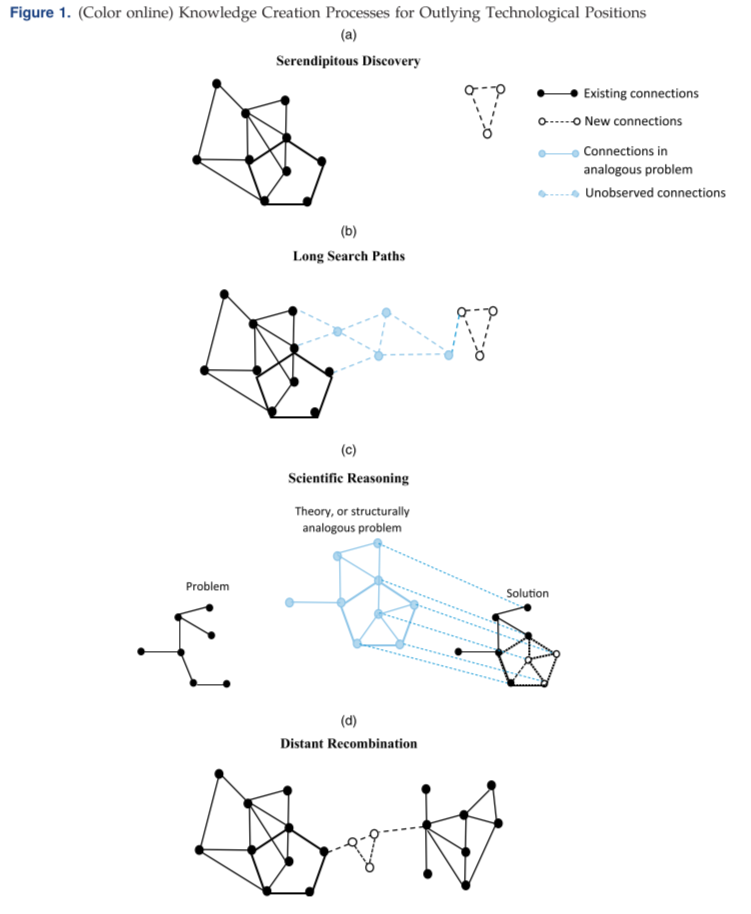 (p. 540)
(p. 540)
may involve scientific reasoning, but not necessarily
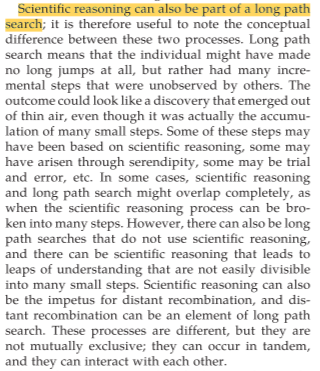 (p. 544)
(p. 544)
also interesting is the idea of distant recombination, which feels like a mix of far conceptual combination and far analogies and outsider innovation, depending on the examples. don't find this to be particularly well theorized. but this connects very well to the way @uzziAtypicalCombinationsScientific2013 and @wangBiasNoveltyScience2017 think about things
two stories illustrate the idea of long search paths
spider-silk lactating goats!
from 1993 to first breakthrough in funding and patenting in like... 2013 or 2015
relevant tabs
BioSteel - Wikipedia: https://en.wikipedia.org/wiki/BioSteel
Scientists breed goats that produce spider silk: https://phys.org/news/2010-05-scientists-goats-spider-silk.html
What happened to those GM spider goats with the silky milk? - AFN: https://agfundernews.com/what-happened-to-those-gm-spider-goats-with-the-silky-milk.html
costas karatzas spider silk - Google Search: https://www.google.com/search?q=costas+karatzas+spider+silk&sxsrf=ALeKk00Q1bDZJfa4TuIUoUSRt3tvmmEeWA%3A1626969038133&ei=zpP5YO62B5Sz5NoPnaaCyAM&oq=costas+karatzas+spider+silk&gs_lcp=Cgdnd3Mtd2l6EAMyBQghEKsCOgUIABCwAzoHCAAQsAMQHjoGCAAQFhAeOgUIIRCgAToHCCEQChCgAUoECEEYAVD5O1jiS2DGTWgBcAB4AIABX4gBngeSAQIxM5gBAKABAaoBB2d3cy13aXrIAQLAAQE&sclient=gws-wiz&ved=0ahUKEwju1c_8g_fxAhWUGVkFHR2TADkQ4dUDCA4&uact=5
Costas Karatzas Inventions, Patents and Patent Applications - Justia Patents Search: https://patents.justia.com/inventor/costas-karatzas
funcitonal flow cytometry (basically a new way to do super-specific and super-sensitive detection of radioactivity)
60+ years!
this really reminds me of dunbar's claim about [[CLM - far analogies are systematically overrated in their importance for creative breakthroughs due to memory bias - @dunbarHowScientistsThink1997]]
and [[EVD - A molecular biologist who had made a major scientific conceptual change did not recall any of the spontaneous analogies used to enact that change - @dunbarHowScientistsThink1997]]
second part of the paper is empirical quant analysis though, relating inventor (team) characteristics to p(outlier) in terms of novelty/distance from similar patents (so basically super novel above some threshold of quality?).
methods notes
definition of outliers: patents that, at the time of filing, were at least two steps away from all preexisting patents in terms of the USPTO mainline subclasses. used this technique to classify ~1.5M patents filed between 1990 and 2000, of which ~120k (~8%) were outlier patents by this definition.
 (p. 537)
(p. 537)
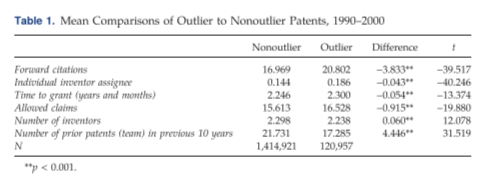
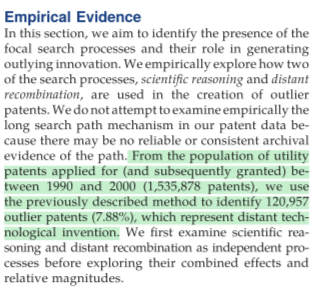 (p. 546)
(p. 546)
definition of distant recombination: essentially the number of unique fields (per NBER 38 industry classifications) the inventor(s) (solo or team) had successfully patented within 10 years += year of application. collective breadth is total number of fields in the team, and max breadth is largest per-inventor count of fields.
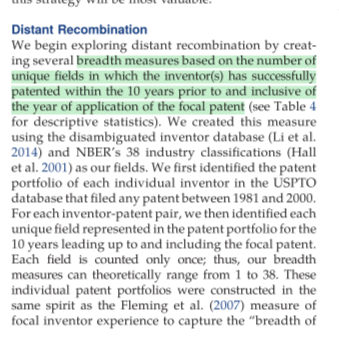 (p. 548)
(p. 548)
 (p. 548)
(p. 548)
 (p. 548)
(p. 548)
estimation: logit (linear?) regression
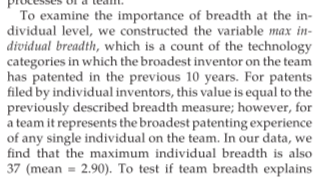 (p. 547)
(p. 547)
most interesting result for us is the breadth of inventor backgrounds and patenting experience
- for inventor breadth of fields (additive effects on top of that for team breadth): [[EVD - patenting teams with a greater number of prior patenting fields were more likely to generate patents that were technological outliers - @kneelandExploringUnchartedTerritory2020]]
- for patenting experience
discussion
distant recombination measure makes me a bit grumpy: it's a diversity measure rather than a distance measure (which is how it's theorized)